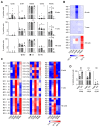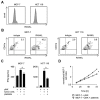Inhibition of NK Reactivity Against Solid Tumors by Platelet-Derived RANKL
- PMID: 30813611
- PMCID: PMC6468810
- DOI: 10.3390/cancers11030277
Inhibition of NK Reactivity Against Solid Tumors by Platelet-Derived RANKL
Abstract
NK cells play an important role in tumor immunosurveillance. Their reactivity is governed by various activating and inhibitory surface receptors, which include several members of the TNF/TNF receptor family. For more than 50 years, it has been recognized that tumor immunosurveillance and in particular NK cell antitumor reactivity is largely influenced by platelets, but the underlying mechanisms remain to be fully elucidated. Here we report that upon activation, which reportedly occurs following interaction with cancer cells, platelets upregulate the TNF family member RANKL. Comparative analysis of the expression of RANK among different NK cell subsets and RANKL on platelets in cancer patients and healthy volunteers revealed a distinct malignant phenotype, and platelet-derived RANKL was found to inhibit the activity of normal NK cells against cancer cells. Notably, NK cell antitumor reactivity could be partially restored by application of denosumab, a RANKL-neutralizing antibody approved for treatment of benign and malignant osteolysis. Together, our data not only unravel a novel mechanism of tumor immune evasion mediated by platelets, but they also provide a functional explanation for the clinical observation that denosumab, beyond protecting from bone loss, may prolong disease-free survival in patients with solid tumors.
Keywords: NK cells; RANK/RANKL; cancer; denosumab; immune evasion; metastasis; platelets.
Conflict of interest statement
The authors declare no conflict of interest.
Figures






Similar articles
-
Receptor activator for NF-κB ligand in acute myeloid leukemia: expression, function, and modulation of NK cell immunosurveillance.J Immunol. 2013 Jan 15;190(2):821-31. doi: 10.4049/jimmunol.1201792. Epub 2012 Dec 14. J Immunol. 2013. PMID: 23241893
-
Platelet-derived transforming growth factor-beta down-regulates NKG2D thereby inhibiting natural killer cell antitumor reactivity.Cancer Res. 2009 Oct 1;69(19):7775-83. doi: 10.1158/0008-5472.CAN-09-2123. Epub 2009 Sep 8. Cancer Res. 2009. PMID: 19738039
-
GITR ligand provided by thrombopoietic cells inhibits NK cell antitumor activity.J Immunol. 2012 Jul 1;189(1):154-60. doi: 10.4049/jimmunol.1103194. Epub 2012 May 30. J Immunol. 2012. PMID: 22649191
-
Role of RANK ligand and denosumab, a targeted RANK ligand inhibitor, in bone health and osteoporosis: a review of preclinical and clinical data.Clin Ther. 2012 Mar;34(3):521-36. doi: 10.1016/j.clinthera.2012.02.002. Clin Ther. 2012. PMID: 22440513 Review.
-
Role of the RANK/RANKL pathway in breast cancer.Maturitas. 2016 Apr;86:10-6. doi: 10.1016/j.maturitas.2016.01.001. Epub 2016 Jan 11. Maturitas. 2016. PMID: 26921922 Review.
Cited by
-
NK Cell Interaction With Platelets and Myeloid Cells in the Tumor Milieu.Front Immunol. 2020 Dec 23;11:608849. doi: 10.3389/fimmu.2020.608849. eCollection 2020. Front Immunol. 2020. PMID: 33424862 Free PMC article. Review.
-
The role of platelets in the regulation of tumor growth and metastasis: the mechanisms and targeted therapy.MedComm (2020). 2023 Sep 14;4(5):e350. doi: 10.1002/mco2.350. eCollection 2023 Oct. MedComm (2020). 2023. PMID: 37719444 Free PMC article. Review.
-
Platelet-Expressed TNFRSF13B (TACI) Predicts Breast Cancer Progression.Front Oncol. 2021 Mar 17;11:642170. doi: 10.3389/fonc.2021.642170. eCollection 2021. Front Oncol. 2021. PMID: 33816291 Free PMC article.
-
Bidirectional Interaction Between Cancer Cells and Platelets Provides Potential Strategies for Cancer Therapies.Front Oncol. 2021 Oct 14;11:764119. doi: 10.3389/fonc.2021.764119. eCollection 2021. Front Oncol. 2021. PMID: 34722319 Free PMC article. Review.
-
Association of non-insulin-based insulin resistance indices, mean platelet volume and prostate cancer: a cross-sectional study.BMC Cancer. 2025 Apr 28;25(1):795. doi: 10.1186/s12885-025-13839-0. BMC Cancer. 2025. PMID: 40295970 Free PMC article.
References
-
- Nieswandt B., Hafner M., Echtenacher B., Mannel D.N. Lysis of tumor cells by natural killer cells in mice is impeded by platelets. Cancer Res. 1999;59:1295–1300. - PubMed
Grants and funding
LinkOut - more resources
Full Text Sources
Other Literature Sources

